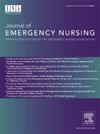Adult Patients’ Experiences of Closed Reduction Treatment for Distal Radius Fracture in the Emergency Department ‐ A Qualitative Descriptive Study
IF 1.8
4区 医学
Q2 EMERGENCY MEDICINE
引用次数: 0
Abstract
Introduction
Distal radius fractures are common injuries managed frequently in emergency departments. While numerous studies focus on the surgical treatment of distal radius fractures, there is a lack of research about non-surgically treated patients' early experiences post-injury. The objective of this study was to explore adult patients' initial experiences following closed reduction treatment of distal radius fracture in the emergency department.
Methods
This qualitative study involved semi-structured telephone interviews with 21 patients who underwent closed-reduction treatment at 2 hospitals in Southern Denmark. Interviews were conducted within the first week following ED treatment and analyzed thematically.
Results
Patients were aged 42 to 91, and 3 were men. Three major themes emerged: (1) Pain Management: Patients reported significant pain during waiting periods and treatment, indicating a need for improved pain management strategies; (2) Information Dissemination: Participants expressed a need for clearer, continuous communication about their treatment and recovery expectations; and (3) Beyond the fracture: Patients were anxious about future functional abilities, especially those with dominant hand fractures, underscoring the need for holistic patient care that addresses psychological and social dimensions.
Discussion
Effective pain management, both pharmacological and non-pharmacological, as well as comprehensive, clear communication, is crucial in the initial treatment phase of distal radius fracture. Acknowledging patients' broader concerns can enhance the quality of care and support improved recovery outcomes. These findings imply that future emergency nursing practice should prioritize swift and effective pain management, clear and empathetic communication, and a holistic approach to patient care to optimize recovery outcomes.
成人患者在急诊室接受桡骨远端骨折闭合复位治疗的经历--一项定性描述性研究。
简介桡骨远端骨折是急诊科经常处理的常见损伤。虽然许多研究都集中在桡骨远端骨折的手术治疗上,但对非手术治疗患者受伤后的早期经历却缺乏研究。本研究旨在探讨成年患者在急诊科接受桡骨远端骨折闭合复位治疗后的初期经历:这项定性研究对丹麦南部两家医院的 21 名接受闭合复位治疗的患者进行了半结构化电话访谈。访谈在急诊科治疗后的第一周内进行,并进行了专题分析:患者年龄在 42 岁至 91 岁之间,其中 3 人为男性。出现了三大主题:(1)疼痛管理:患者表示在等待和治疗期间有明显的疼痛感,这表明需要改进疼痛管理策略;(2)信息传播:参与者表示需要就他们的治疗和康复期望进行更清晰、持续的沟通;(3) 骨折之后:患者对未来的功能能力感到焦虑,尤其是那些显性手部骨折的患者,这突出表明需要对患者进行整体护理,以解决心理和社会方面的问题:讨论:在桡骨远端骨折的初期治疗阶段,有效的疼痛管理(包括药物和非药物治疗)以及全面、清晰的沟通至关重要。承认患者更广泛的关切可提高护理质量,有助于改善康复效果。这些研究结果表明,未来的急诊护理实践应优先考虑迅速有效的疼痛管理、清晰和富于同情心的沟通,以及全面的患者护理方法,以优化康复效果。
本文章由计算机程序翻译,如有差异,请以英文原文为准。
求助全文
约1分钟内获得全文
求助全文
来源期刊
CiteScore
3.10
自引率
11.80%
发文量
132
审稿时长
46 days
期刊介绍:
The Journal of Emergency Nursing, the official journal of the Emergency Nurses Association (ENA), is committed to the dissemination of high quality, peer-reviewed manuscripts relevant to all areas of emergency nursing practice across the lifespan. Journal content includes clinical topics, integrative or systematic literature reviews, research, and practice improvement initiatives that provide emergency nurses globally with implications for translation of new knowledge into practice.
The Journal also includes focused sections such as case studies, pharmacology/toxicology, injury prevention, trauma, triage, quality and safety, pediatrics and geriatrics.
The Journal aims to mirror the goal of ENA to promote: community, governance and leadership, knowledge, quality and safety, and advocacy.

 求助内容:
求助内容: 应助结果提醒方式:
应助结果提醒方式:


